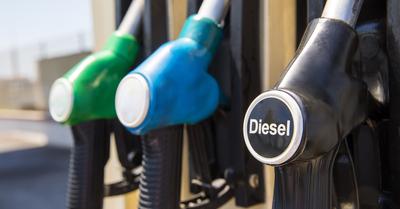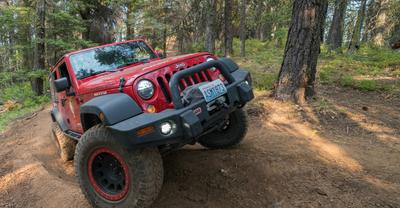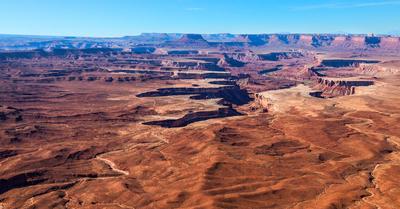Off-road diesel is a clean and inexpensive fuel. But is it the same as regular diesel, and is it legal to use?
Off-road diesel, or red diesel, is regular diesel fuel that isn’t taxed. This fuel is dyed red to denote its tax-exempt status, and it’s only legal to use on private property for commercial, agricultural, or industrial reasons—never on public roads.
In this article, we’ll cover everything you need to know about off-road diesel. We’ll compare it to highway diesel, cover its many uses, and explain when it is (and isn’t) legal to use off-road diesel in a truck or car.
We sourced the information used in this article from reputable sources, including state fuel laws and agricultural organizations.
This article may contain affiliate links where we earn a commission from qualifying purchases.
Is Off-Road Diesel Different?
There’s absolutely no difference between off-road diesel and regular diesel when it comes to fuel quality or production. They are exactly the same fuel, and an engine that runs regular diesel can also use off-road diesel. However, not every diesel engine is allowed to use off-road diesel.
Is Off-Road Diesel Cheaper?
Yes, off-road diesel is cheaper in every state where it is sold. It doesn’t matter what the average price of diesel is—off-road diesel will be cheaper than that. The cost of off-road diesel varies between states, and it’s usually cheaper wherever fuel is cheaper in general.
Off-Road Diesel Vs Red Diesel
Is off-road diesel the same thing as red diesel? In most areas, red diesel and off-road diesel are exactly the same things. Red diesel is used by off-road vehicles, tractors, generators, and industrial applications. The terms “red diesel” and “off-road diesel” are used interchangeably by both users and distributors of this fuel.
Who Can Use Off-Road Diesel?
Off-road diesel isn’t for everyone. The diesel itself contains a red dye to denote its purpose, which is strictly for vehicles and engines that do not operate on public roads. Off-road diesel isn’t taxed, unlike regular fuel. The reason they don’t tax off-road diesel is to make it cheaper to run farm equipment. It’s kind of like a subsidy.
Technically, driving on public roads with red diesel or off-road diesel is tax evasion. It’s illegal everywhere, as normal fuel taxes that pave roads and fund public services aren’t paid when you purchase it. Fines for using off-road diesel are very high, and it also takes away from farmers and industries that rely on this cheaper fuel to operate.
You can use off-road diesel for farm equipment and for vehicles that only operate on private property.
Off-Road Diesel Uses
Off-road diesel is used for all kinds of tasks, and they’re not limited to farming. Tractors and agricultural equipment use an enormous amount of red diesel, as it saves farmers a significant amount of money when running heavy equipment.
Construction vehicles, such as cranes, rollers, and bulldozers, are also allowed to use off-road diesel when operating on a job site. People use off-road diesel in industrial generators, welding equipment, pumps, large machines, and other applications.
Off-road diesel is also a popular heating fuel, especially on the east coast. It’s cleaner and more efficient than heavier fuel oils such as No. 2 heating oil, and it’s also cheaper than other forms of heat in some parts of the country. Heating with oil is not nearly as common as it used to be, but many homes still get periodic red diesel deliveries.
Illegal Off-Road Diesel Use Penalties
The penalties for illegally using off-road diesel vary between states, but they’re typically significant. Some states issue a flat fine and a penalty assessment based on the quantity of red diesel found in your fuel tank. In California, for example, the penalty for using red diesel increases by $10 for every gallon you have in your possession.
Can You Use Off-Road Diesel On The Trail?
This is a common question with a somewhat complicated answer. Trucks can’t use off-road diesel on public roads—period. This is the law pretty much everywhere, and there aren’t any notable exceptions.
This is important to remember when considering using off-road diesel on a trail, as the majority of trails are actually considered public roads. So in most cases, you can’t use off-road diesel in your truck—even when driving on dirt roads and off-road trails.
This covers national parks, national forests, public off-road trails, local country roads, wildlife preserves, state trust land, and other areas where people frequently drive off-road.
However, you can use off-road diesel on your own private property when engaged in some sort of work, such as mowing or checking on livestock. Just make sure you don’t end up on a public road of any kind while using off-road diesel.
Is Off-Road Diesel Bad For Your Engine?
Other than the red dye, off-road diesel is the same fuel as regular diesel. Many people believe that off-road diesel is dirtier, less efficient, or somehow worse for your engine than regular diesel. This is incorrect, and using off-road diesel in your equipment will not wear it out any slower or faster than regular diesel.
However, off-road diesel sometimes suffers from the same issues that affect marine diesel. Marine diesel and off-road diesel are often stored in older tanks, above ground, or pumped with older equipment.
This can increase the chances of getting contaminated diesel, as industrial equipment is a lot less picky about fuel quality than your average new diesel truck or car. This is why it’s essential to have a functional fuel/water separator and a good fuel filter when using off-road diesel.
What Does Off-Road Diesel Cost?
Off-Road diesel is sold in bulk. Typically, the cost is lower per gallon if you buy in larger quantities. Prices are usually set in tiers as follows: 1 to 499 gallons, 500 to 999 gallons, 1000 to 1999 gallons, 2000+ gallons, and 3000+ gallons. The average national price of off-road diesel is usually about a dollar lower than on-road diesel.
As of the writing of this article, the average price of on-road diesel is $3.94 per gallon, and the average price of a typical quantity of off-road diesel is $2.94 per gallon. For 2000+ gallons, the price goes down to $2.81 per gallon. As you can see, the price difference between on and off-road diesel is huge, but the price difference between large and small quantities of off-road diesel is not quite so big.
How Do You Get Off-Road Diesel?
Red diesel is available in many locations but rarely at traditional gas stations. You’ll probably have to go to an industrial fueling lot or fuel distribution center to find red diesel, though some agricultural gas stations sell it as well. Most red diesel lots pump it directly from large tanks into your tanks, which many people tow in on trailers.
In most states, you can’t just pull up and fill tanks with red diesel. Instead, you’ll have to get a permit or an exemption of some kind. This process varies, but you usually have to prove that you have a legitimate use for the fuel.
In the state of Texas, for example, you can apply for a Tax Exempt Certificate from your local Comptroller’s Office. The certificate will allow you to legally purchase and use red diesel from a fueling station, which is relatively common in most parts of the state.
Additionally, many companies offer red diesel delivery services. These services send a truck out to your property or worksite and fill your on-site fuel tanks, and the cost of delivery and fuel is still significantly lower than purchasing on-road diesel for off-road use.
You usually won’t need a permit to get off-road diesel for heating, as heating companies only fill designated fuel tanks that are made for heaters. These tanks are usually located outside or in the basement and can only be filled or drained with the right tools.









